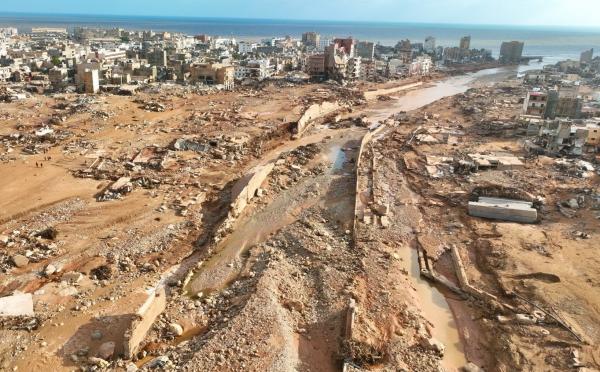Libyans briefly united in response to deadly floods in Derna
18 Sep 2023 by The Water Diplomat

Libyans, divided and ruled by two rival governments since 2014, have united briefly in response to the disaster caused by storm Daniel in early September. The storm produced 8 months of rain in 24 hours and led to the collapse of two dams, resulting in a wall of water rushing through the city of Derna in the early morning of the 11th of September, creating Africa’s deadliest flood on record.
According to Asma Khalifa, research fellow at the German Institute for Global and Area Studies, and as reported by Al Jazeera, political instability in Libya has played a role in the disaster. The east of Libya has suffered historical negligence which is part of the grievances currently held in this region against the government in Tripoli. Budgets allocated for dam maintenance have not been used to stabilize the structures, and locals have in the past voiced concerns about dam safety. According to the website of a Turkish company, Arsel Construction Company Limited, the company was awarded a contract to maintain the dams in 2007, and the project was completed in 2012. However, a report by a Libyan state-run audit agency in 2021 stated that the two dams had not been maintained despite the allocation of 2,3 million U.S. $ towards this aim.
Another factor in the disaster is the impact of climate change. The storm had already caused damage before reaching Libya: on the 4th of September, a strong Mediterranean storm system developed over Greece - and was named Daniel by the Greek Meteorological Services - causing catastrophic floods across Bulgaria, Greece and Turkey. In July, the Mediterranean Sea had reached its highest recorded temperature of 28.71°C, beating its previous record measured in 2023 of 28.25°C. The higher temperatures are associated with the development of powerful storms, bordering on the strength of hurricanes, which have recently been termed ‘Medicanes’. In a study from 2022, higher temperatures in the Mediterranean, which is highly vulnerable to climate change, had already been associated with higher mortality death rates. But the death toll from storm Daniel was exceptional, listing among the 20 most deadly floods worldwide and the deadliest on the African continent since 1900 .
By the 10th of September, the storm struck the north-eastern coast of Libya, creating catastrophic conditions that led to the loss of an estimated 5,300 human lives and approximately 9,800 persons still missing. According to an update by the International Federation of the Red Cross (IFRC) on the 13th of September, 1.6 million people were exposed to the storm, which has led to some 13,000 casualties and 21,000 internally displaced persons (IDPs). The storm resulted in 284 education facilities and 128 health care facilities being flooded.
The storm reached its peak on the 10th of September, with torrential rains flooding cities, especially the city of Derma, which suffered thousands of deaths. According to the World Meteorological Organisation (WMO), Libya’s National Meteorological Centre issued early warnings for this extreme weather event 72 hours in advance, notifying government authorities and urging them to take preventive measures. However, residents in Derna were not clearly warned or urged to evacuate the city and were taken by surprise by the extreme events.
Derna was severely impacted: a quarter of the city, with an esti,ated population of population of 90,000-100,000, straddles the Wadi Derna – a seasonal river – was completely destroyed by a powerful, 7 metre-high wave of water that was released when two dams along the Wadi Derna collapsed under the force of the water. The Wadi Derna rises in the Jebel Akhdar mountains and is some 60 km long, flowing in an easterly direction to the town of Derna, where it flows into the Mediterranean. The two dams – the Derna dam and the Mansour dam – had a joint capacity of 19.5 million m³ and there were concerns about the flood risk of the dams: CNN highlighted a research paper from 2022 which warned that the basin was exposed to flood risk and had suffered from five deadly floods since 1942. The dams were built in the 1970’s and were in need of maintenance since 2002. Since the floods, concerns have been voiced over the safety of two more dams: the Jaza dam between Darna and Benghazi, and the Qattara dam near Benghazi. However, officials have reported that they are confident that these dams are safe.
Although most road infrastructure into the city was impassable as a result of the storm, one road remained usable and has been the main artery through which local humanitarian aid is being transported. More than 100 volunteers from the western side of Libya drove to the eastern city of Derma to provide support in the relief efforts. Ministers from the Tripoli-based government visited the eastern city of Benghazi as well as Derna on the 13th and 14th of September to assess the damage. The Libyan Red Crescent was among the first responders, supported by the International Federation of Red Cross and Red Crescent Societies (IFRC) and the International Committee of the Red Cross (ICRC). In addition, humanitarian and military aid has been provided by Algeria, Egypt, France, Iran, Italy, Japan, Jordan, Kuwait, Palestine, Qatar, Turkey the UAE, the United Kingdom, the United States, the United Nations, and the European Union. The United Nations provided prepositioned aid through the World Health Organisation and has appealed to donors for U.S. $ 71 million to support relief efforts.
